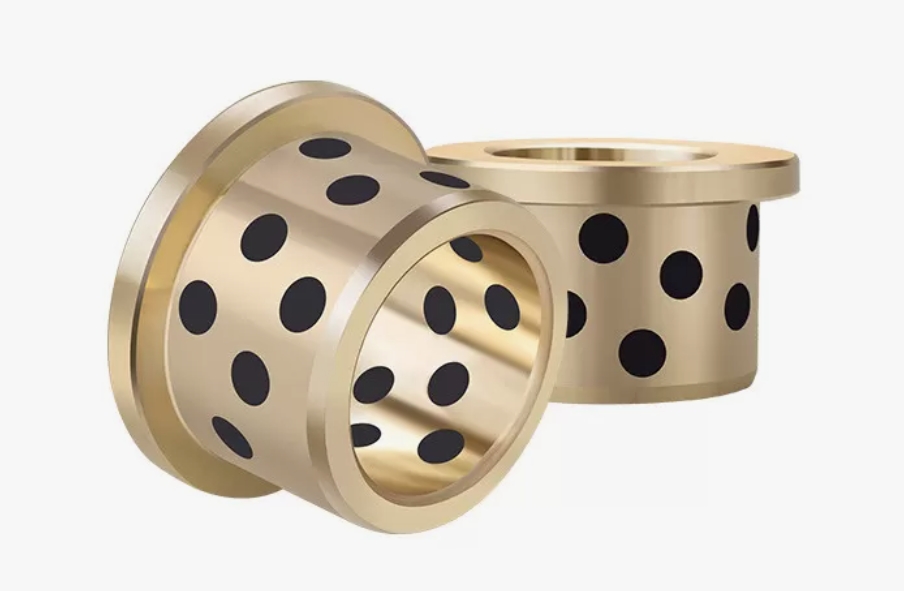In the area of industrial applications, efficiency and longevity of machinery are paramount. One key component contributing to these goals is the self-lubricating graphite oilless bushing. These bushings are engineered to deliver excellent wear resistance and maintenance-free operation across diverse industrial environments.
What Are Oilless Bushings?
Oilless bushings, also known as self-lubricating bushings, are specialized components designed to reduce friction and wear between moving parts in machinery without the need for continuous external lubrication. These bushings are engineered with materials that possess inherent lubricating properties, making them suitable for a wide range of industrial applications.

Composition and Materials
Oilless bushings can be made from various materials, each offering distinct properties that cater to specific applications. Here’s a closer look at some of these materials, including brass:
Graphite
Graphite is a common component in oilless bushings due to its excellent lubricating properties. As a solid lubricant, graphite reduces friction and wear between moving parts. It creates a self-lubricating effect, which ensures the bushing can function effectively without needing additional lubrication.
Bronze
Bronze, particularly graphite-impregnated bronze, is widely used in oilless bushings. This combination provides a strong structural framework along with the self-lubricating benefits of graphite. Bronze bushings offer high wear resistance and durability, making them suitable for heavy-duty applications.
Brass
Brass is another material used in the composition of oilless bushings. Brass bushings, often integrated with solid lubricants like graphite, provide several benefits:
Corrosion Resistance: Brass is highly resistant to corrosion, which makes it suitable for use in environments exposed to moisture and various chemicals.
Durability: Brass offers good durability and can withstand substantial wear and tear, ensuring a long service life.
Thermal Conductivity: Brass has excellent thermal conductivity, which helps in dissipating heat generated by friction, thereby enhancing the performance and lifespan of the bushing.
Self-Lubrication: When combined with solid lubricants like graphite, brass bushings provide a self-lubricating feature, reducing the need for external lubrication.
Other Solid Lubricants
In addition to graphite, other solid lubricants such as PTFE (polytetrafluoroethylene) can be used to enhance the self-lubricating properties of the bushing. These materials help in further reducing friction and wear, ensuring smoother operation of the machinery.
The Innovation of Oilless Bushings
Oilless bushings represent a significant advancement in bearing technology. Traditional bushings require constant lubrication to reduce friction and wear. In contrast, graphite bronze bushings utilize solid lubricants like graphite to achieve a self-lubricating effect. This unique composition significantly extends the service life of machinery while reducing the need for regular maintenance.
Key Features and Benefits
1. Excellent Wear Resistance
Graphite bushings exhibit excellent wear resistance, making them ideal for applications subjected to continuous stress and friction. The presence of graphite not only reduces wear but also minimizes the chances of seizing and galling, thus enhancing the overall durability of the bushing.
2. High Load Capacity
Designed to perform under high-stress conditions, these bushings are suitable for high load, low speed applications. They possess a remarkable load-bearing capacity, making them perfect for heavy machinery and equipment used in industries such as manufacturing, mining, and construction.
3. High Temperature Environments
Graphite oilless bushings are engineered to withstand high temperature environments. This makes them highly suitable for applications where traditional lubricants would fail, ensuring reliable performance even under extreme heat.
4. Maintenance-Free Operation
One of the standout advantages of these bushings is their maintenance-free operation. The self-lubricating properties of graphite reduce the need for frequent lubrication, thereby cutting down maintenance costs and downtime. This feature is particularly beneficial for industries where continuous operation is critical.
Diverse Industrial Applications
Injection Molding Machines
In injection molding machines, precision and reliability are crucial. Graphite bushings provide a maintenance-free solution with superior lubricating properties, ensuring smooth and efficient operation.
Heavy Load Machinery
For heavy-duty applications, such as those found in construction and mining, the high load capacity and excellent wear resistance of graphite oilless bushings ensure durability and longevity, even under the most demanding conditions.
Oil-Free Environments
In industries where contamination from lubricants is a concern, oil-free bushings are a necessity. Graphite bushings eliminate the need for an oil film, making them ideal for cleanroom environments and food processing applications.
Conclusion
The advent of self-lubricating graphite oilless bushings marks a significant step forward in bearing technology. With their high load capacity, excellent wear resistance, and maintenance-free operation, these bushings are transforming the way industries approach machinery maintenance and efficiency. Whether in high temperature environments or applications demanding heavy load capabilities, graphite bushings provide a reliable, cost-effective solution that enhances the service life of machinery while reducing downtime and maintenance costs. As a professional oilless bushing manufacturer and self-lubricating system provider, we would be pleased to advise you individually, and you are also welcome to send your inquiry to sales@zjbearings.com.